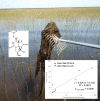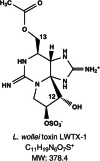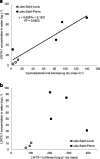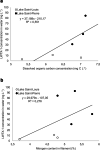Cyanotoxin release from the benthic, mat-forming cyanobacterium Microseira (Lyngbya) wollei in the St. Lawrence River, Canada
- PMID: 32458304
- PMCID: PMC7378124
- DOI: 10.1007/s11356-020-09290-2
Cyanotoxin release from the benthic, mat-forming cyanobacterium Microseira (Lyngbya) wollei in the St. Lawrence River, Canada
Abstract
Benthic cyanobacterial mats occurring in the St. Lawrence River fluvial lakes Saint-Louis and Saint-Pierre are dominated by Microseira (Lyngbya) wollei which produce several cyanotoxins including LWTX-1 that is characteristic of Microseira wollei. This cyanotoxin is not only present in the filaments forming benthic mats, but was also measured in the water overlying the mats. LWTX-1 was found in all cyanobacterial filament samples (75.29-103.26 ng mg-1) and all overlying water samples (3.01-11.03 ng L-1). Toxin concentrations measured in overlying water and dry biomass were strongly correlated (r = 0.94). Furthermore, LWTX-1 concentration in water was positively correlated with the dissolved organic carbon in water (r = 0.74) and % nitrogen content in cyanobacterial filaments (r = 0.52). A preliminary study was conducted to determine the release and degradation rates of LWTX-1 from a M. wollei mat kept under laboratory conditions over a 3-month period. Toxin measurements revealed an early, massive toxin release followed by a typical decaying function, with a half-life in the order of 17 days. Our results raise concerns about the occurrence and downstream advection of dissolved cyanotoxins from Microseira mats in the aquatic environment. Graphical abstract.
Keywords: Benthic cyanobacterial mat; Cyanotoxin release; Mass spectrometry; Microseira (Lyngbya) wollei.
Conflict of interest statement
The authors declare that they have no conflict of interest.
Figures






Similar articles
-
Spatial and temporal variations of a saxitoxin analogue (LWTX-1) in Lyngbya wollei (Cyanobacteria) mats in the St. Lawrence River (Québec, Canada).Harmful Algae. 2016 Jul;57(Pt A):69-77. doi: 10.1016/j.hal.2016.06.001. Epub 2016 Jun 22. Harmful Algae. 2016. PMID: 30170723
-
Detection and confirmation of saxitoxin analogues in freshwater benthic Lyngbya wollei algae collected in the St. Lawrence River (Canada) by liquid chromatography-tandem mass spectrometry.J Chromatogr A. 2012 Jan 6;1219:93-103. doi: 10.1016/j.chroma.2011.10.092. Epub 2011 Nov 7. J Chromatogr A. 2012. PMID: 22169195
-
Growth of the harmful benthic cyanobacterium Microseira wollei is driven by legacy sedimentary phosphorous.Harmful Algae. 2022 Aug;117:102263. doi: 10.1016/j.hal.2022.102263. Epub 2022 Jun 9. Harmful Algae. 2022. PMID: 35944964
-
The rise of toxic benthic Phormidium proliferations: A review of their taxonomy, distribution, toxin content and factors regulating prevalence and increased severity.Harmful Algae. 2016 May;55:282-294. doi: 10.1016/j.hal.2016.04.002. Epub 2016 Apr 27. Harmful Algae. 2016. PMID: 28073542 Review.
-
Neurotoxic cyanobacterial toxins.Toxicon. 2010 Oct;56(5):813-28. doi: 10.1016/j.toxicon.2009.07.036. Epub 2009 Aug 4. Toxicon. 2010. PMID: 19660486 Review.
Cited by
-
A Fresh Perspective on Cyanobacterial Paralytic Shellfish Poisoning Toxins: History, Methodology, and Toxicology.Mar Drugs. 2025 Jun 27;23(7):271. doi: 10.3390/md23070271. Mar Drugs. 2025. PMID: 40710496 Free PMC article. Review.
-
Cyanotoxins in Epipelic and Epiphytic Cyanobacteria from a Hypersaline Coastal Lagoon, an Environmental Hazard in Climate Warming Times and a Potential Source of New Compounds.Mar Drugs. 2024 Jul 24;22(8):334. doi: 10.3390/md22080334. Mar Drugs. 2024. PMID: 39195450 Free PMC article.
References
-
- Chorus I, Bartram J (1999) Toxic cyanobacteria in water: a guide to their public health consequences, monitoring and management. World Health Organization. https://apps.who.int/iris/handle/10665/42827
-
- Foss AJ, Phlips EJ, Yilmaz M, Chapman A. Characterization of paralytic shellfish toxins from Lyngbya wollei dominated mats collected from two Florida springs. Harmful Algae. 2012;16:98–107. doi: 10.1016/j.hal.2012.02.004. - DOI
MeSH terms
LinkOut - more resources
Full Text Sources

